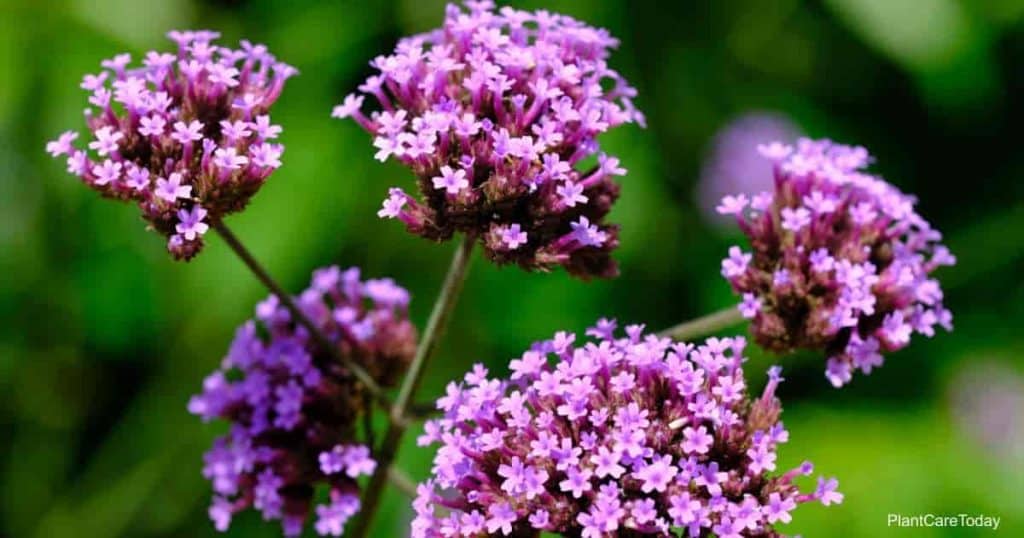Verbena officinalis (ver-BEE-nuh oh-fiss-ih-NAH-liss) is the botanical name for the common verbena. It is a perennial herb native to Europe belongs to the Verbenaceae family.

The common name include:
- Simpler’s joy
- Mosquito plant
- Wild Hyssop
- Blue Vervain
- Prostrate Verbena
- Herb of the cross
- Vervain
It is recommended for USDA hardiness zones 4-8.
The Verbena plant is known to attract bees, flies, and wildlife. It is considered to be a hermaphrodite and able to self-pollinate.
In most cases, it grows naturally in wasteland areas and along the side of roads. The plants are a massive draw for butterflies and moths.
The name ‘Officinalis’ alludes to its pharmacological use which we will look at later.
Verbena Officinalis Care
Size & Growth
Verbena officinalis grows to a height of up 38″ – 40” inches and a width between 20” – 40” inches. The height is fully achieved within 1-2 years’ time. After which the plant may continue to spread.
Flowering and Fragrance
The flower petals are usually between blue to purple or pink to red. They are usually made up of 5 petals. The main flowering season is either in the summer or autumn.
There seems to be a fusion in the center of the flower, where the petals congregate, taking the shape of a cup.
Light & Temperature
Verbena officinalis requires full sun exposure to thrive. The leaves and flowers should not be sprayed with water when it is very hot.
This will usually lead to them being sunburned. Lightly shaded areas are ideal.
Fully grown plants are more resistant to the cold. When planting seeds to working with your plants, protect them from frost.
They will not survive temperatures of 32° degrees Fahrenheit and under. Keeping the young plants indoors would be an ideal solution in the winter.
Watering and Feeding
You are encouraged to water this plant at regular intervals. Time should be permitted for the water to run all the way through the soil.
This should be done without allowing the plant to complete dry out.
Verbena Officinalis do not require feeding. They generally get all their nutrients from the soil. If the soil is particularly devoid of nutrients, you can occasionally use liquid fertilizer.
Soil & Transplanting
Verbena officinalis thrive in soil that is well-drained by reasonably moist. Chalk, sand, or loamy soil is ideal. They do not do well in acidic soil.
This is evident in the regions that they naturally occur. When planting in soil that is not porous, such as clay. Mixing it with pebbles may help.
Transplanting is fairly straightforward. As long as the plant is strong enough to be lifted, it will usually survive and thrive in its new location.
The best approach is to ensure that the roots are in good health. This significantly increases the chances of success.
Grooming and Maintenance
Most of the grooming is done with the aim of facilitating growth. Flower stems must be cut back as soon as they are spent. This allows room for others to grow.
Related: Golden Dewdrop Care (Duranta Erecta)
How To Propagate Verbena Officinalis
Propagation can be carried out through seeds, cuttings, or by division. The seeds and to be sown under minimum covering, in early spring.
They will take up to 3 weeks to germinate. At which point you should allow them to grow a little stronger. Strong shoots should be moved to their own pots.
Cuttings propagation is carried out by harvesting the plant at its base. You are looking to get shoots that have some stem attached to them. This should be done to shoots that are at least between 3.15” inches and 3.9” inches tall.
Once harvested, the cutting should have its own pot to grow in. They are not to be exposed to severe heat until they are well-rooted.
Division can be done any time outside of the growing season. You are looking to maintain each division’s roots as you move it to a new pot.
The best results are usually seen when the pots are not crowded. Divisions can be sown directly into the ground. Shading is encouraged until the plants are well-rooted.
Verbena Officinalis Pests or Diseases
Is The Vervain Plant Toxic or Poisonous?
Although this plant is not considered to be toxic to humans or pets, there are some potential risks attached to it. Pregnant women are discouraged from consuming it as it often leads to uterus stimulation.
Is The Vervain Blue Invasive?
Although this plant self-pollinates it does not spread extensively. As such it is not considered to be invasive.
Suggested Verbena Officinalis Uses
Both the flowers and the leaves of this plant are considered to be edible. They are usually consumed as a tea.
Caution is encouraged as high doses of verbenalin, which is contained in Verbena Officinalis can paralyze the nervous system. This would lead to stupor and convulsion.
Besides the tea, the leaves can be parboiled and eaten when seasoned. This is certainly an acquired taste. The flowers make a great garnish.
From a medicinal standpoint, verbena officinalis is taken internally and used to treat illnesses such as headaches and fevers. Although it is not to be given to pregnant women, it has sometimes been used to aid contraction during labor.
External medicinal use includes the treatment of eczema and gum disease. The stems of verbena officinalis and its leaves are known to have antibacterial, anticoagulant, antispasmodic, mildly diuretic among other medicinal properties. [Source]
For decorative purposes, Verbena officinalis is suitable for placement in patio containers.